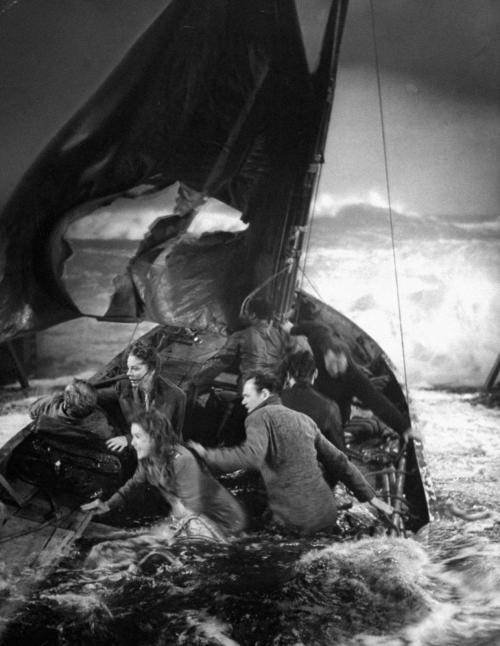cinephiliabeyond: The first in Alfred Hitchcock’s series of limited-setting films, the 1944 Am
cinephiliabeyond: The first in Alfred Hitchcock’s series of limited-setting films, the 1944 American drama thriller Lifeboat is a remarkable proof of the filmmaker’s expertise and power at creating tension stemming from different personalities stuck together in only a couple of square meters of space. A story of a handful of people inhabiting a lifeboat after a German submarine sinks the merchant ship they were on during the Second World War, Lifeboat is clearly an allegorical portrayal of the Allied forces and a cinematic expression of their need to unite, forget their differences and stop jumping on each other’s throats in order to defeat the hated enemy. The German side is represented by the captain of the Nazi submarine which caused all this turmoil, a guy called Willi whom the passengers save from the sea without knowing who he really is. It’s curious to note that, had Willi been depicted as a slightly less competent and intelligent man, Hitchcock’s film might have achieved better box office results.The problem put forward by some influential film critics and political columnists at that time is that Lifeboat could be read as a piece of Nazi propaganda—why is the German character shown to be much more competent and determined than the desperate representatives of the United States and the UK? Discouraged by these remarks, 20th Century Fox allegedly held back with promoting the picture. Angered by the same comments, and further encouraged by the way Hitchcock and a whole gallery of screenwriters changed his screenplay, John Steinbeck requested his name be removed from the project. These accusations seem far-fetched these days, as it seems rather obvious that what Hitchcock and his screenwriting crew did with the story and its powerful German antagonist was create a simple and effective way of pointing to the historical fact that Germany took the world by surprise and punished the unprepared, passive, distrusting Western powers with careful planning and relentless execution.The simple truth is that this specific work of art is a masterfully composed, spatially contained little thriller that not only offers some sublime acting and typically crafty direction, but also stands apart from the rest of Hitchcock’s corpus as something entirely different, innovative and original. Luckily enough, a lot of critics responded positively to it, even though it’s still maintained that Lifeboat didn’t quite get all the praise and recognition it deserved. Even if we remove the heavy, inescapable political context out of the picture, Lifeboat remains a very effective and skillful exploration of the human nature. As food rations dwindle and water supplies disappear, with no rescue ship in sight, all the masks are thrown overboard and we see human beings coming to terms with the immediate reality of pain and death. Starring Tallulah Bankhead, William Bendix, Walter Slezak and others, based on Hitchcock’s original idea and John Steinbeck’s subsequent novella, later worked on by screenwriter Jo Swerling, filmed in black-and-white by Glen MacWilliams and further distinguished by its utter lack of music except for the opening and closing credits, surgically precise and psychologically deep in its theme, Lifeboat is truly one of the highlights of Hitchcock’s career.Alfred Hitchcock’s ‘Lifeboat’: An Expertly Composed Allegorical Thriller That Deserves More Recognition -- source link




